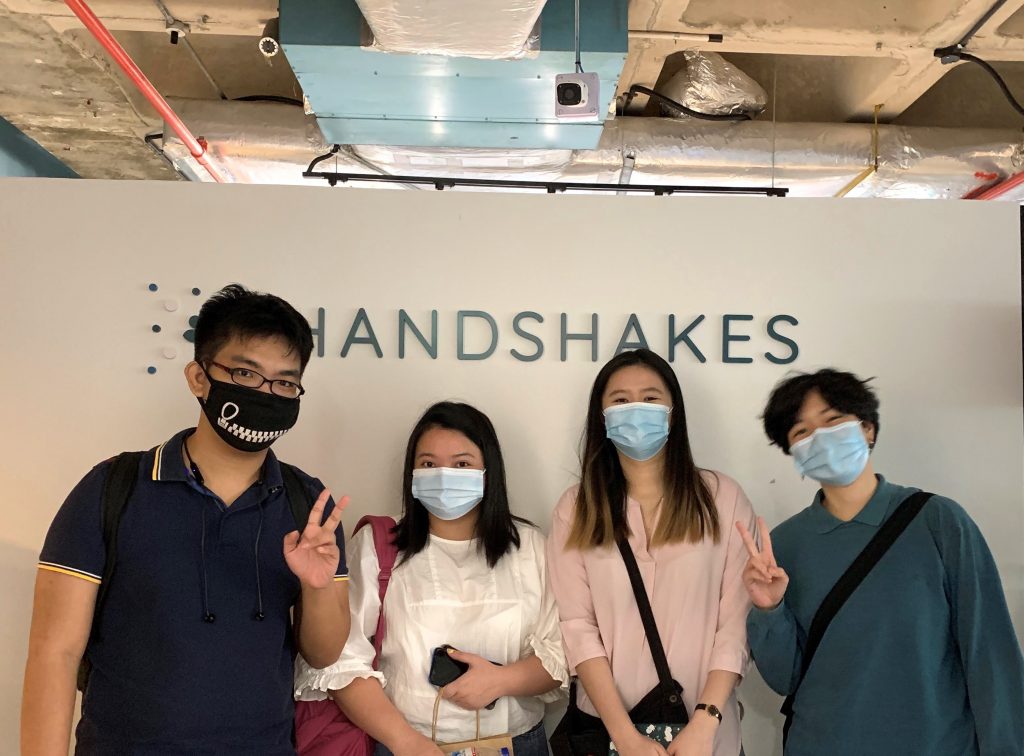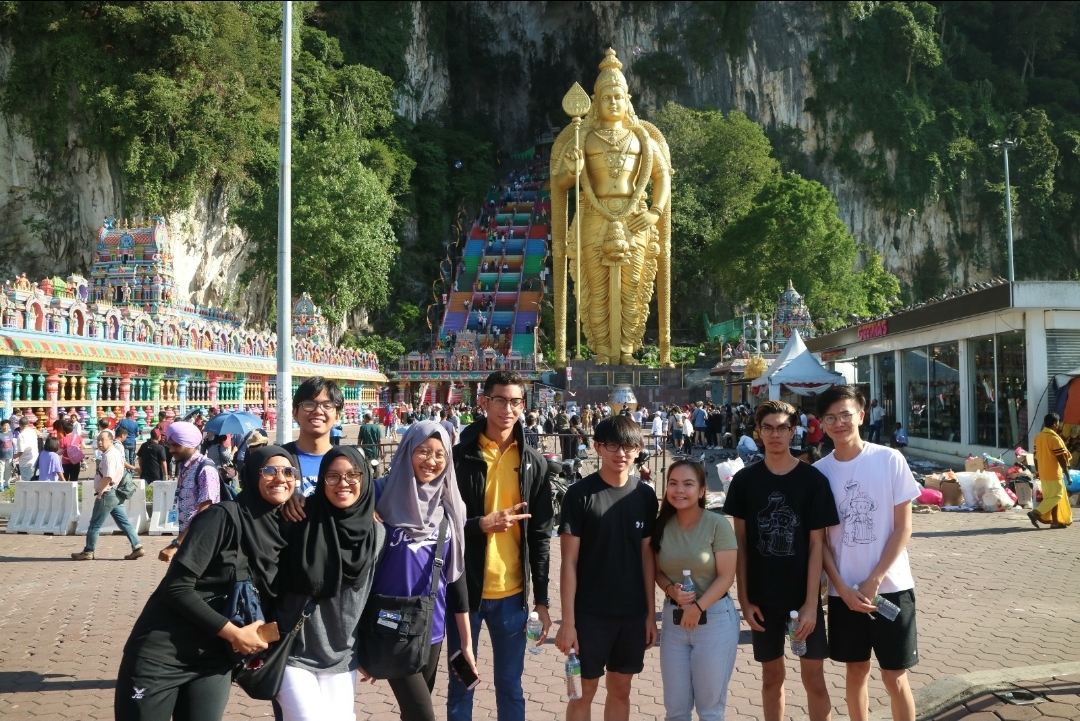Top image: Alya, fourth from left, in an overseas trip around the ASEAN region. Image: Alya Irdina Binte Salim.
Most young Singaporeans who undertake work attachments or internships expect to spend their time in a glass-and-steel skyscraper in the CBD, hovering silently just outside the orbit of their supervisor, only to be noticed when the need for coffee pouring arises. In other words, it’s not always a useful experience for understanding how a company functions and picking up skills relevant to the industry.
Such internships limit your perspective to what is happening within Singapore’s borders, when what is crucial nowadays is regional exposure and familiarity with ASEAN. Fortunately, this wasn’t the case for 20-year-old polytechnic student Alya Irdina Binte Salim’s project internship with ProfilePrint (a food ingredient analysis platform).
Supported by National Youth Council’s Asia-Ready Exposure Programme (AEP), Alya’s project internship is part of NYC’s efforts to provide Singapore youths with overseas exposure opportunities through projects that are co-curated with partners from the various industries. At the end of the project, youths will gain an understanding of both the cultural context of, and economic opportunities in, the ASEAN member states, China, and India.
Therefore, instead of brewing coffee for her colleagues and clients in Raffles Place offices, Alya had the chance to talk to Indonesian, Bangladeshi, and Rwandan coffee farmers as her work involved speaking to—and clinching deals with—clients and brands around the ASEAN region.
“I’ve spoken to many different overseas and local brands,” Alya says, “which [has let me] make quite a few ‘friendships’ with them.”
The friendships that Alya has forged with our ASEAN partners are crucial to the future of Singapore. ASEAN is fast becoming a “tech battleground”, with technology companies like Tencent, Grab, Bytedance, etc., pouring millions of dollars into the region and vying for the wallets of ASEAN’s burgeoning tech-savvy population.
Thus, for Singapore to remain at the forefront of these up-and-coming digital industries, youths must, like Alya, reach out to the region and make connections and friendships.
Why ASEAN?
If we consider ASEAN’s economic potential collectively, it skyrockets to become the world’s fifth largest economy. In numerical terms, that’s a GDP of around US$3 trillion in 2019, according to Ho Suu Wei, PayPal’s Southeast Asia Government Relations Director, who was a featured speaker of NYC’s Asia-Ready Webinar Series.
Detractors who find it problematic considering ASEAN as a unified bloc (akin to the European Union, for example) need only look at concrete statistics to be proven wrong. Cross-border purchases in the ASEAN region “already represent almost a quarter of Singapore’s US$12 billion annual online spend”, reports a PayPal study conducted in 2020. Moreover, 38% of these transactions are conducted on mobile devices.
In other words, in 2020, business is no longer conducted on a local or even physical basis, thanks to technology. As Mr Ho puts it, “ASEAN markets today have transcended beyond their geographical parameters.”
This means that youths in Singapore have to get familiar with digital technologies and look beyond our shores to thrive—especially if we want a piece of the US$ 4 trillion consumer market that ASEAN is projected to represent over the next decade.
The harsh reality is that “Singapore’s economy is not big enough to sustain interest from multinational companies,” notes Associate Professor Simon Tay, another featured speaker of the Webinar Series. As Chairman of Singapore Institute of International Affairs (SIIA), which is also the knowledge partner for AEP, Professor Tay’s warning must not be taken lightly.
Therefore, he advises that youths in Singapore must treat Singapore as “a gateway to the region”. Singapore youths who take the time to grow familiar with ASEAN put themselves in the advantageous position of serving as an ambassador to the region, thus ensuring that their skills and expertise will always stay relevant.
The AEP Gave Young Singaporeans New Perspectives On ASEAN
Indeed, after interacting and making connections with regional business leaders during their project internships, these AEP alumni developed a new perspective on ASEAN.
Some, like 24-year-old university graduate Rachael Wong, even changed their minds about their future career plans to take into account the opportunities the region offers.

After undergoing an AI Machine Learning internship with Handshakes, a corporate intelligence company that works closely with the Vietnamese, Rachael realised that “technology and digitalisation is ever changing and improving … hence it’s important to pay attention to these changes”. Seeking a path in ASEAN can not only build your career but also refine your “communication and people skills, as well as having a sense of social awareness”, she says.
For Matthew Loo Jun Kuan, a 23-year-old undergraduate who, like Alya, took on a project internship with ProfilePrint, ASEAN is important because it leads the way in the digital revolution, or what many call the fourth industrial revolution.
He says, “In countries like Thailand and Indonesia, the start-up scene is very vibrant … whereas tried-and-tested pathways [in Singapore] can stifle innovation and growth.”
Matthew is not wrong: there is a phenomenon called “the late-mover advantage” that, somewhat unintuitively, asserts that new businesses can innovate and outsell established companies.
This is exactly what is happening in ASEAN. Mr Ho explains that smartphones and fast wireless connections have proliferated in rural areas of ASEAN, skipping an entire generation of slow, bulky computers—which makes ASEAN inhabitants pioneers of a new digital revolution. People from ASEAN, for instance, spend the most time accessing the internet on their smartphones compared to everyone else in the world.
The pandemic has accelerated this trend even faster. As face-to-face meetings are reduced to a bare minimum to prevent the spread of the coronavirus, technology has become the main medium of interaction for both personal and business purposes. Anyone who does not keep up with this digital frontier, then, will be at a disadvantage.
Indeed, Matthew’s AEP experience has taught him that Singapore youths must go beyond our country’s borders to seize the opportunities that rapid digitalisation brings, even if they work in traditionally low-tech, high touch fields.

As Matthew realised while interning at ProfilePoint, “even traditional sectors like food and commodities are also being disrupted by technology. It has convinced me to build up my skillsets in these areas so that I can stay relevant to the workforce.”
Echoing Professor Tay, he adds, “I think people tend to neglect the size of ASEAN and its potential for growth … [But] it is [important] to build collaborations with organisations from other countries and to tap on them to reach out to a much larger consumer base.”
“The recent signing of Regional Comprehensive Economic Partnership involved major economies like China, Japan, and ASEAN, representing 29% of the global GDP. That has also made me realise that the strength of ASEAN would be magnified when represented as a bloc of countries rather than as disjointed economies.”
This is a sentiment that has stuck with Alya after her AEP experience, particularly in light of the Covid-19 pandemic which has upended many industries.
“I had the mindset that working in ASEAN countries may not be as good as getting job opportunities from Western countries and thought that there are not that many jobs around,” she reflects.
“After undergoing AEP, I realised that I was wrong. In my internship industry alone, there are … job opportunities in ASEAN countries and they always think of ways on how to create opportunities for people.
“For example, I’ve learnt that someone started a business by using coffee bean shells and turning them into utensils … So I do believe that ASEAN countries have many job opportunities that are interesting and that you may never experience anywhere else.”
As Alya concludes, “If you don’t take the risk [of venturing out of Singapore], you will never know what you missed out on … getting to see a different environment really helps you to understand how different our countries are, and you shouldn’t be nervous about getting to learn at work environments and spaces that are different from Singapore’s.”
This article is brought to you by the National Youth Council.
How else can Singapore youths tap on the opportunities around ASEAN? Tell us your ideas at community@ricemedia.co. If you haven’t already, follow RICE on Instagram, Spotify, Facebook, and Telegram.






